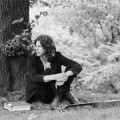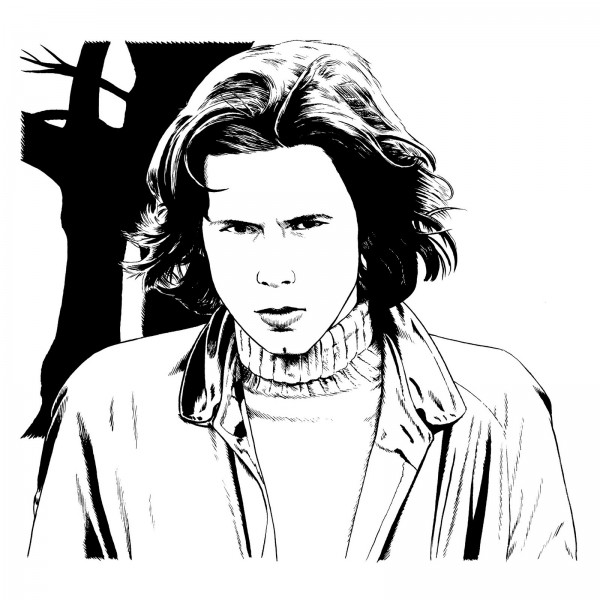SOUND OPINIONS: For the most part we think that rock ‘n’ roll artistry and commercials don’t mix, but in the case of Nick Drake, it worked out. A 1999 TV commercial featuring his 1972 track “Pink Moon,” made the English singer/songwriter a household name. It was success Drake couldn’t enjoy in his lifetime. He died at age 26 of an overdose on anti-depressants after only releasing three albums. But the small catalog lives large today, with Drake’s work influencing R.E.M., Elliot Smith, Beth Orton and many more. He’s remembered on the new tribute album Way to Blue, produced by the man who discovered him, Joe Boyd. In addition to working with Bob Dylan, Pink Floyd and the Fairport Convention, Joe Boyd produced Nick’s first two albums, Five Leaves Left in 1969 and Bryter Layter in 1970. Jim and Greg talk to him about Nick Drake’s own influences, his style and his legacy. MORE
WIKIPEDIA: In 1965, Drake paid £13 for his first acoustic guitar, and was soon experimenting with open tuning and finger-picking techniques.[14] In 1966, Drake won a scholarship to study English literature at Fitzwilliam College, University of Cambridge. He delayed attendance to spend six months at the University of Aix-Marseille, France, beginning in February 1967. While in Aix, he began to practice guitar in earnest, and to earn money would often busk  with friends in the town centre. Drake began to smoke cannabis, and that spring he travelled with friends to Morocco, because, according to travelling companion Richard Charkin, “that was where you got the best pot”.[19] Drake most likely began using LSD while in Aix,[20] and lyrics written during this period—in particular for the song “Clothes of Sand”—are suggestive of an interest in hallucinogens.[21]
with friends in the town centre. Drake began to smoke cannabis, and that spring he travelled with friends to Morocco, because, according to travelling companion Richard Charkin, “that was where you got the best pot”.[19] Drake most likely began using LSD while in Aix,[20] and lyrics written during this period—in particular for the song “Clothes of Sand”—are suggestive of an interest in hallucinogens.[21]
Upon returning to England, he moved into his sister’s flat in Hampstead, London, before enrolling at Cambridge University that October. His tutors found him to be a bright student, but unenthusiastic and unwilling to apply himself to study.[22] Dann notes that he had difficulty connecting with staff and fellow students alike, and points out that official matriculation photographs from this time reveal a sullen and unimpressed young man.[23] Cambridge placed much emphasis on its rugby and cricket teams, yet by this time Drake had lost interest in playing sport, preferring to stay in his college room smoking marijuana, and listening to and playing music. According to fellow student (now psychiatrist) Brian Wells: “they were the rugger buggers and we were the cool people smoking dope.”[23] In September 1967, he met Robert Kirby, a music student who went on to orchestrate many of the string and woodwind arrangements for Drake’s first two albums.[24] By this time, Drake had discovered the British and American folk music scenes, and was influenced by performers such as Bob Dylan, Josh White and Phil Ochs. He began performing in local clubs and coffee houses around London, and in February 1968, while playing support to Country Joe and the Fish at the Roundhouse in Camden Town, made an impression on Ashley Hutchings, bass player with Fairport Convention.[25] Hutchings recalls being impressed by Drake’s skill as a guitarist, but even more so by “the image. He looked like a star. He looked wonderful, he seemed to be 7 ft.”[16] [76] MORE
WIKIPEDIA: At some time during the night of 24/25 November 1974, Nick Drake died at home in Far Leys, Tanworth-in-Arden, from an overdose of amitriptyline, a type of antidepressant. He had gone to bed early the night before, after spending the afternoon visiting a friend. His mother stated that, around dawn, he left his room for the kitchen. His family was used to hearing him do this many times before but, during this instance, he did not make a sound.  They presumed that he was eating a bowl of cereal. He returned to his room a short while later, and took some pills “to help him sleep”.[77] Drake was accustomed to keeping his own hours; he frequently had difficulty sleeping, and would often stay up through the night playing and listening to music, then sleep late into the following morning. Recalling the events of that night, his mother later stated: “I never used to disturb him at all. But it was about 12 o’clock, and I went in, because really it seemed it was time he got up. And he was lying across the bed. The first thing I saw was his long, long legs.”[78] There was no suicide note, although a letter addressed to Ryde was found close to his bed.[79]
They presumed that he was eating a bowl of cereal. He returned to his room a short while later, and took some pills “to help him sleep”.[77] Drake was accustomed to keeping his own hours; he frequently had difficulty sleeping, and would often stay up through the night playing and listening to music, then sleep late into the following morning. Recalling the events of that night, his mother later stated: “I never used to disturb him at all. But it was about 12 o’clock, and I went in, because really it seemed it was time he got up. And he was lying across the bed. The first thing I saw was his long, long legs.”[78] There was no suicide note, although a letter addressed to Ryde was found close to his bed.[79]
At the inquest that December, Drake’s coroner stated that the cause of death was as a result of “Acute amitriptyline poisoning—self-administered when suffering from a depressive illness”, and concluded a verdict of suicide. Though this has been disputed by some members of his family,[2] there is a general view that accidental or not, Drake had by then given up on life.[40] Rodney described his son’s death as unexpected and extraordinary; however, in a 1979 interview he admitted to “always [being] worried about Nick being so depressed. We used to hide away the aspirin and pills and things like that.”[76] Boyd has stated that he prefers to believe the overdose was accidental. He recalled that Drake’s parents had described his mood in the preceding weeks as having been very positive, and that he had planned to move back to London to restart his music career. Boyd believes that this levity was followed by a “crash back into despair”. Reasoning that Drake may have taken a high dosage of his antidepressants to recapture this sense of optimism, he said he prefers to imagine Drake “making a desperate lunge for life rather than a calculated surrender to death”.[80] Writing in 1975, NME journalist Nick Kent comments on the irony of Drake’s death at a time when he had just begun to regain a sense of “personal balance”.[67] In contrast, Gabrielle Drake has said she prefers to think Drake committed suicide, “in the sense that I’d rather he died because he wanted to end it than it to be the result of a tragic mistake. That would seem to me to be terrible.”[76] MORE
JOE BOYD: I met the creative team who put the ad together and they were a bunch of kind of slackers from an alternative Boston ad agency. And this guy told me that they built the whole storyboard for the ad around a track by The Church, and the night before the presentation to Volkswagen he was sitting at home smoking . . . something . . . and listening to Pink Moon and he suddenly had this blinding insight that this was the track – not The Church track. — ALL THINGS CONSIDERED, 4/21/13
RELATED: Fade in to a moonlit river, an isolated bridge, and a carload of recent college graduates. Acoustic guitar strums, both urgent and plaintive, are joined by a husky voice, uttering lyrics that border on making rational sense but never quite get there: “Saw it written and saw it say, pink moon is on its way.” When the voice intones “pink moon,” the camera points skyward and we see from the perspective of the passengers a bright full moon, the light of which fills the clear night sky. The music and visuals evoke a feeling of quiet magic and mystery, enhanced by the hazy purpose of what we’re seeing. Is this a movie trailer, a product advertisement, or the beginning of a TV program? Next question: with something this lovely, does it matter?
The four young people pull up to their destination—a party that seems excessively boisterous by comparison to the enchanting ride that brought them there. They hesitate, glance at each other, and silently communicate their shared wish for more backroads, more moonlight, more windblown hair, and, presumably, more of the beautiful music that has continued to play throughout this quietly dramatic scene. They drive off to embrace what they have decided is more valuable in this moment. They choose the journey over the destination. At this point, it’s still unclear what exactly we’re seeing. Finally, nearly a full minute into the piece, the famous Volkswagen logo appears against the same starry sky the moon has been filling. Volkswagen. The Cabrio. Drivers Wanted. We instantly recall that the car has been the focal point of their shared communing with the night.
You’ve probably seen the commercial embedded above. If you’re a fan of Nick Drake’s music, it’s probably because of this Cabrio ad that featured his song “Pink Moon.” Drake lingered in obscurity during his brief, three-album career and for decades after his untimely, depression-related death by overdose (and probable suicide) in 1974. In the late 1990s, he slowly began to move into the public consciousness, as Rykodisc released a new Best Of collection and more and more artists began to cite Drake as an influence. Then, the Cabrio ad and a well-nigh meteoric rise to posthumous fame. So that’s one reason why I feel compelled to argue that the “Pink Moon” VW Cabrio ad is the Commercial of the Decade. Without it, thousands if not millions fewer people would know that Nick Drake made some of the most beautiful, haunting music of the twentieth century. MORE
DAILY MAIL: This haunting image of doomed actor Heath Ledger shows him apparently drowning in a bath – in a bizarre tribute to the tragic British folk singer with whom he was obsessed. The picture comes from a film Ledger made about Nick Drake, the cult singer-songwriter whose death bore disturbing similarities to his own. Ledger made the dark, brooding film to accompany one of the last songs Drake recorded before killing himself with antidepressants in 1974, at the age of 26. Like Drake, Ledger, 28, was found dead in his bed after taking prescription antidepressants. In stills taken from Ledger’s video for the song Black Eyed Dog – an allusion to Sir Winston Churchill’s description of depression as the “black dog” – the actor can be seen singing of his misery before apparently drowning in a bath. MORE

